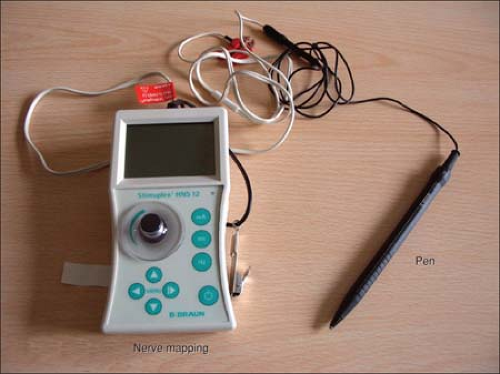Technical Considerations for Pediatric Regional Anesthesia
Giorgio Ivani
Valeria Mossetti
A. Nerve Mapping in Children
Equipment
For many years there has been a lack of specific material to perform regional anesthesia in infants and children. Radial artery catheterization sets, epidural kits, and peripheral and central venous catheter sets have been used for continuous peripheral nerve blocks. Nowadays for a safe performance it is mandatory to use dedicated pediatric tools. Any peripheral nerve can be blocked either by infiltrating a local anesthetic within a compartment space through which the nerve runs or by precisely locating the nerve. Compartment blocks such as intercostal block, intrapleural block, fascia iliaca compartment block, penile block, etc., depend on the localization of the fascial plane; when the relevant fascia is unique with no underlying vital structure, different needles such as an IM needle, can be safely used. When there are several fascial planes or a danger of damaging important anatomical structures, such as with an ilioinguinal block, only a short-beveled or pinpoint needle should be selected. Precise localization of a plexus or a nerve trunk must not be performed by seeking paresthesias with standard IM needles because of the danger of direct nerve damage; only short-beveled needles, insulated and connected to a nerve stimulator are suitable. For most peripheral nerve blocks in children, 21- to 23-gauge, 35- to 50-mm long needles are used, depending on the type of block and on the age of the child. Eliciting a motor response using a nerve stimulator is the most useful and safe technique for performing a pediatric nerve block. Since the plexuses in children are quite superficial, especially the brachial plexus at the axilla, before introducing the needle, try to detect the position of the plexus with the transcutaneous technique. After having introduced the tip of the needle, connect it to the neurostimulator and set it to stimulate at a frequency of 2 Hz. Starting with a current of 1 to 1.5 mA, the needle is advanced until distinct contractions of the nerves to be blocked are noticed. The optimum nerve location is achieved by adjusting the needle so that these contractions are still visible with currents of 0.4 mA. It is now possible
to inject the bolus dose of local anesthetic. Remember that, as nerves are thin and very closely linked to each other without sheaths dividing them, one twitch of a single nerve is enough to administer the drug without looking for a multiple-twitch technique.
to inject the bolus dose of local anesthetic. Remember that, as nerves are thin and very closely linked to each other without sheaths dividing them, one twitch of a single nerve is enough to administer the drug without looking for a multiple-twitch technique.
Mapping of Nerves in Pediatric Regional Anesthesia
In the new century, regional anesthesia in the pediatric field has reached worldwide acceptance. Safety and efficacy have been evidenced in a major survey showing that pediatric regional anesthesia has a low rate of complications and no major sequelae or deaths. Light sedation or anesthesia plus a block offers optimal pain control throughout surgery, allowing also good postoperative analgesia. Peripheral blocks are employed more and more, but thus far they are still less common than central blocks even though in the same survey their safety was superior—no complications in more than 9,000 blocks.
One of the problems connected with the performance of a peripheral block, even with the mandatory use of a nerve stimulator (NS), is a thorough knowledge of the anatomy of children; specifically, the closeness of different structures—nerves, veins, arteries. The small distance between the skin and the nerves can cause, in inexperienced hands, severe injuries while detecting a plexus with the needle.
Adrian Bosenberg published in 2002 a simple but very effective method to improve experience and reduce mistakes during the performance of a peripheral block. The technique, called nerve mapping, requires the use of the unblunted tip of the negative electrode of the NS. It involves increasing the mA of the NS up to 3 mA or more; the skin is touched close to the nerve plexus, causing stimulation until motor responses are elicited, and then the voltage is reduced to detect the best point to perform the block.
In the same year (2002) Urmey and Grossi described the same technique in adults using a device with a needle-through passage obtaining an even more successful performance; in this case they employed a higher voltage, 4 to 5 mA, due to the thickness of the skin in adults; in 2003 they described a modified tool for the same technique.
More recently new devices have been produced by industrial companies using a pen-like stimulator instead of the negative electrode allowing an easier mapping. The NS must be set at 3 mA, 2 Hz, 1 ms (while 0.1 ms is usually used for performing the block with the needle); changing slightly the position of the tip of the pen, a motor response is elicited. The best position can then be chosen (and the best motor response according to the needs of surgery) and marked with a pen (Fig. 46-1).
Nerve mapping is a painless method as the mAs used produce a motor but not a sensory response, and can also be performed in an awake patient. Moreover, children are very often under sedation or anesthesia so that any stress is avoided; in the meantime we can teach the anatomy of a plexus allowing young doctors to detect the nerves without any skin damage.
In this way we can find the different nerve responses of a plexus; radial, medial, ulnar, and musculocutaneous nerves can be elicited for the upper arm, and femoral and sciatic with its components—peroneal and tibial—for the lower limb.
The success rate of blocks in children can be increased, keeping in mind that malformations may make it difficult to place the needle (e.g., arthrogryposis).

Full access? Get Clinical Tree





